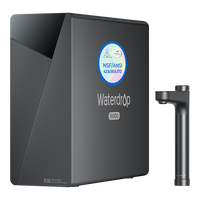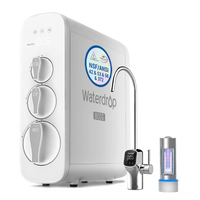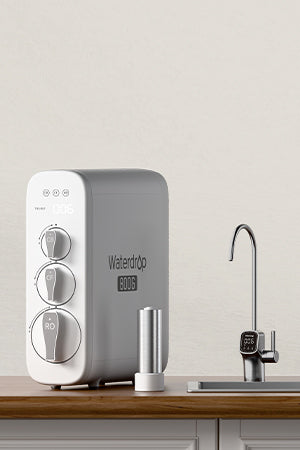The Flint water crisis started in 2014 that exposed the citizen's health with tap water contaminated by brain-damaging lead did shock the public.
And it is just in the very recent,
an analysis conducted by the Chicago Tribune also found that homes in Illinois had the lead levels in tap water as extreme as Flint during the past six years, consisting of hundreds and even thousands of parts per billion.
It is believed that more communities in the United States are exposed to lead. What’s the reason for that?
What makes the city water get contaminated by lead?
The main source of lead exposure can be traced to pipes known as service lines that connect houses to municipal water supplies. Those pipes contain lead corrode, leaching lead into the water while transporting water into your home.
Lead pipes are widely used in transporting water supplies in the United States until the late 20th century when they are recognized as harmful to people’s health.
Although lead pipes are banned from use in the US since 1986, there have been no national requirements to remove those already installed lines, and there are an estimated 6.5 to 10 million lead service lines still delivering water.
Federal regulations even allow the vast majority of water utilities to hide the hazards from consumers——every year, water bills include a brochure that almost always declares tap water is safe to drink.
Because lead is unnoticeable in color, taste, or smell, consumers generally cannot find the lead in their water unless they test for it.
All those factors cause the water crisis in Flint, Illinois and more communities, which made the citizens exposed to lead-contaminated water for a long period without knowing the fact.
What is the bad effect of lead on our health?
The U.S.Environmental Protection Agency (EPA) and Centers for Disease Control and Prevention (CDC) stress that lead is unsafe to consume at any level.
Even tiny concentrations exposed to children can permanently damage their developing brains, cause learning disabilities, stunted growth, lower IQ, impaired hearing, and behavioral abnormalities.
Adults exposed to lead have a higher risk of heart disease, high blood pressure, kidney failure and other health problems.
There are more than 400,000 deaths a year in the U.S. linked to the toxic metal.
How do you know if you have lead service pipes?
Not all houses have lead pipes. If your house was built before 1986, then there are possibilities that your pipes are made of lead.
To check out if you have lead pipes in your property, first, you have to locate the pipes where water enters your home, which typically is in your basement or where your water meter is installed.
Then, scrape the pipe with the flat edge of a screwdriver or some tool similar; if the area shows as shiny and silver, your service line is made of lead.
If you find that you have a lead service line in your home, replacing the lead pipes with pipes made of safe material as soon as possible is the best way to solve the problem from the root.
However, it is not always safe to only check your home service pipes as there are also pipes that are unrevealed underneath the ground. Your water may travel through those lead pipes before entering your home.
To know what’s in your water, you’d better have your water tested. You can call your local drinking water utility or your county health department to find out how to test your water.
If your water already gets contaminated by lead before it enters your water service line, using a point of use water filter at home would be the best choice.
How do you get rid of lead with home water filtration systems?
There are mainly three kinds of home filtration technologies that are efficient in removing lead from water.
1. Activated Carbon Block
The activated carbon filter is the most cost-efficient way to remove the lead in water. The material is widely used in building water filters. However, different carbon blocks have different filtration efficiency in eliminating contaminants.
Typically, only special treated activated carbon blocks can effectively remove the lead in water. This activated carbon block has a much larger pore surface area and could trap the lead inside the pore structure of a carbon substrate.
A good tip to identify whether the carbon filter can remove lead or not is to check if it is NSF53 certified. Ensure your carbon filter is NSF53 certified to remove lead when you choose one; otherwise, it probably is not that effective.
2. Reverse Osmosis Membrane
Reverse osmosis is known for providing the cleanest water on earth and is the ideal home treatment way to remove lead from water.
It relies on a semi-permeable membrane to filter out impurities from drinking water. The membrane contains microscopic pores, which will allow only water molecules that are smaller than 0.0001 microns to pass through.
As the lead and other heavy metals are larger than the water molecules, water squeezes through the membrane while leaving the lead and other heavy metals behind.
The only point that customers usually assume a drawback for an RO system is that the water it creates is too clean that it even removes those beneficial minerals.
This is a misunderstanding.
For adults, the minerals that they take mainly rely on food. Water only provides a very tiny proportion. And from another perspective, you can also install an adds-on remineralized water filter to your RO system, which could add a certain amount of minerals to your RO water.
3. Distillation
Distillation is the oldest way to filter water which mimics the way nature purifies water.
This kind of water purification system offers clean water through boiling and producing water vapor. When water vapor rises and reaches a cool surface, it will condense back to the liquid form.
Heavy metals like lead and other particles are unable to vaporize, thus remain in the boiling solution.
Conclusion
“There is no training for a water crisis,” said Joseph Roudez, Mayor of University Park, after the water crisis in Chicago.
It is sad that the public hardly recognizes the potential risk of drinking tap water, which is often claimed to be safe to consume. However, once the public is informed to stop using the contaminated tap water, the harm may have already done to their health.
Safe water is essential for us to live a better life. As a citizen, it is crucial to know how to avoid getting exposed to different kinds of contaminants in water, test your home drinking water regularly, and take solutions to ensure your home drinking water safety.









































































